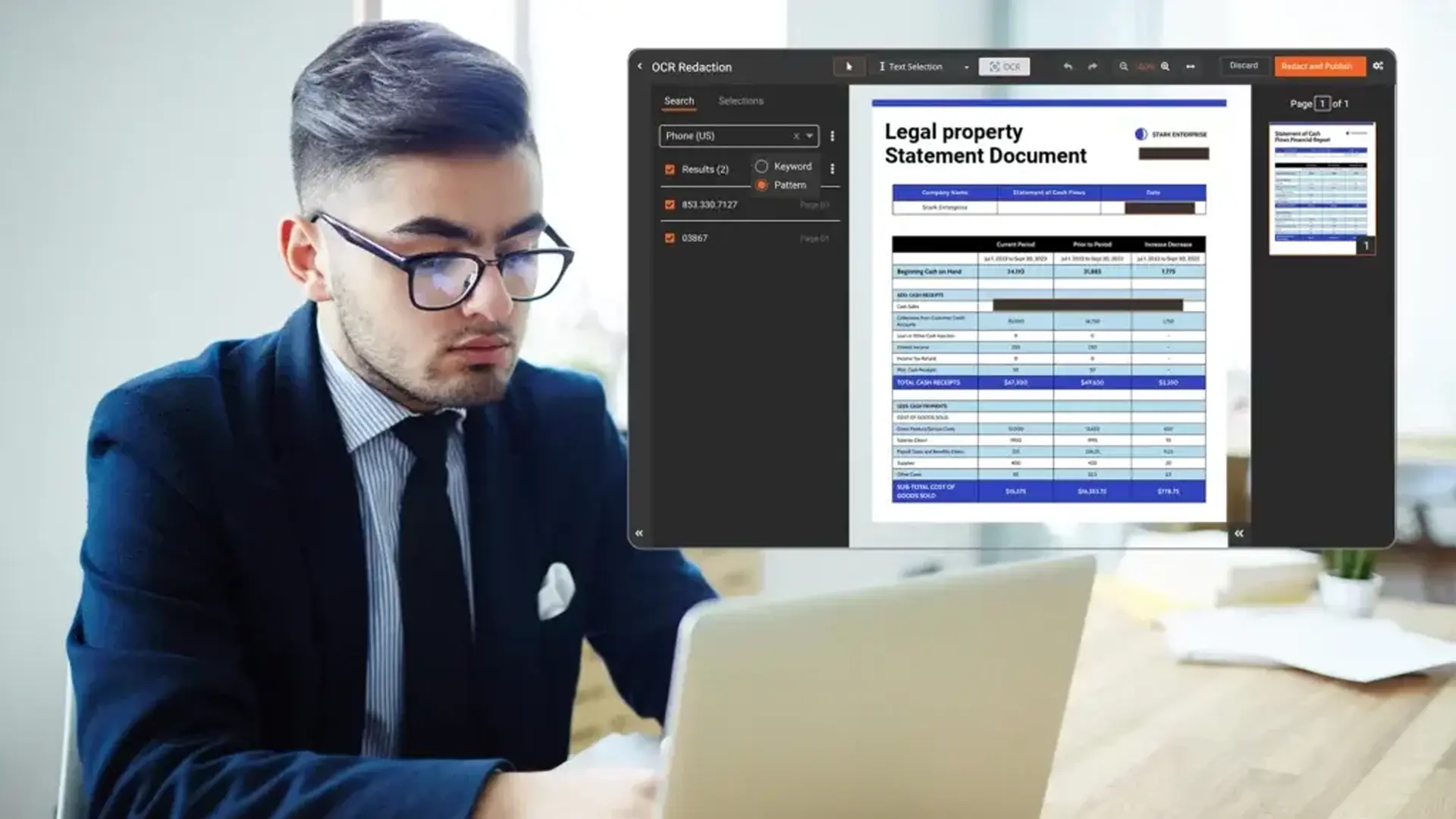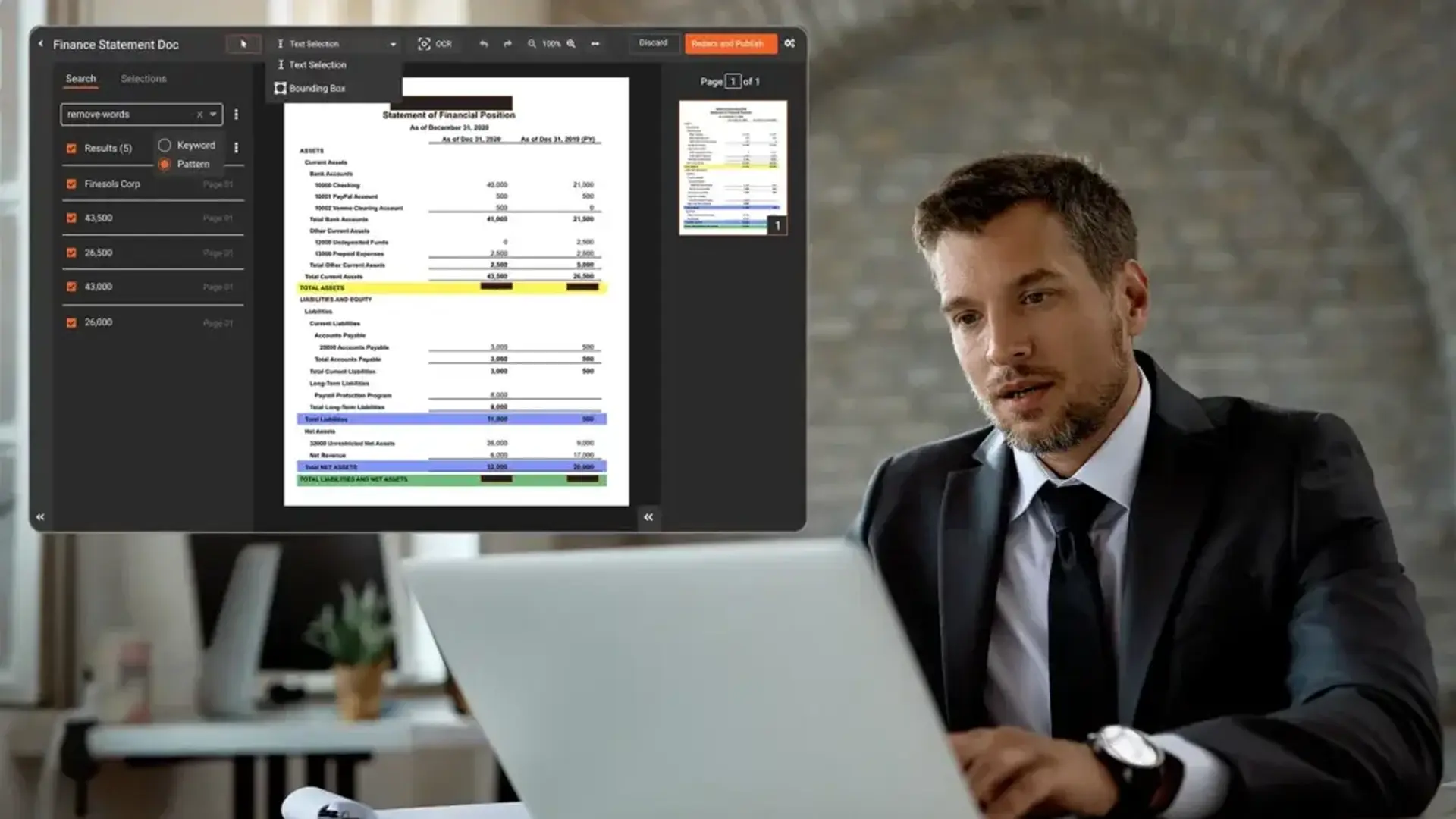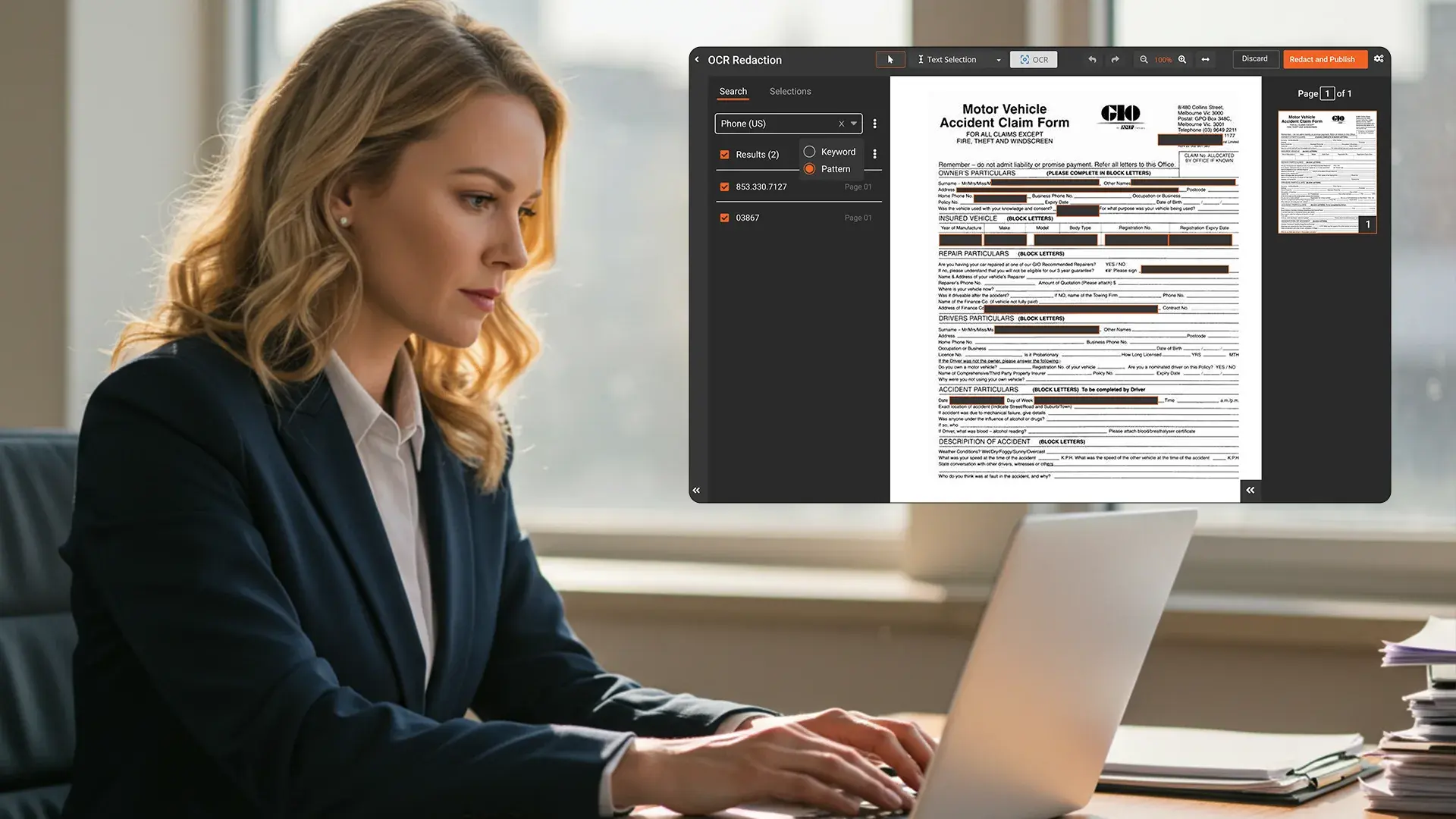How to Redact Legal Documents Using AI-Powered Redaction Software
by Bassam Mazhar, Last updated: December 24, 2025

Legal documents contain confidential and privileged information that must be protected. Explore best practices and leverage AI to redact legal documents while ensuring compliance with key regulations.
Even a small mistake in redacting a legal document can lead to a data breach, court sanctions, or a loss of client trust. From attorney-client emails to trade secrets, the sensitive data in legal files must be protected and processed fast.
As legal professionals, you handle vast amounts of sensitive information, including Personally Identifiable Information (PII), Protected Health Information (PHI), as well as confidential business information such as trade secrets, attorney-client privileged communications, intellectual property, financial records, and much more.
Adequately and timely protecting this information amid the growing volume of cases is crucial, not only for compliance with regulations such as the ABA Model Rules of Professional Conduct, HIPAA, GDPR, and CCPA but also for safeguarding your client data, avoiding legal liabilities, and protecting your firm’s reputation.
With 52% of data breaches involving PII, the need to protect sensitive information adequately has never been greater.
With these considerations in mind, let's explore some of the best practices for redacting legal documents to protect confidential information, avoid mistakes, and ensure compliance with data privacy regulations.
What is Legal Document Redaction?
Legal redaction is the process of permanently removing sensitive or confidential information, such as names, medical records, or privileged communications, from documents before sharing them with clients, courts, or the public.
8 Best Practices to Redact Legal Documents
While the redaction of privileged documents is crucial, adopting best practices to avoid redaction failures is equally essential. Imagine the consequences if a document filled with confidential client information were improperly redacted and released to the public.
Sony experienced this in the Federal Trade Commission v. Microsoft case, where an effort to redact sensitive information using a Sharpie marker was a complete disaster and exposed sensitive and strategic business information about Microsoft’s plans and internal discussions, which included their profit margins, user statistics, internal emails, and communications.
It also happened to a Florida law firm, which faced a $30,000 sanction for accidentally distributing confidential materials. Redaction mistakes like this can cost time, money, and reputation.
These practices involve understanding precisely what information requires redaction, conducting thorough reviews, and complementing these efforts with automated tools to ensure accuracy and completeness.
1. Understand the Data
An essential step in redacting legal documents is identifying the information that needs to be redacted. This includes PII, such as names and Social Security numbers; PHI, like medical records and attorney-client communications; and financial information, such as financial statements, bank account numbers, and credit card numbers.
Here's a handy table to help you determine what needs to be redacted in legal documents.

Industry-specific regulations further define what constitutes sensitive data. For instance, HIPAA protects PHI in the healthcare industry. At the same time, GDPR in the European Union, along with laws like the CCPA and Section 741 of the California Penal Code, set stringent requirements for handling PII in California.
With these regulations in place, incomplete redaction of sensitive data can lead to significant penalties and reputational damage, particularly with GDPR fines reaching up to € 20 million or 4% of the company's global turnover.
2. Create a Backup
Before redacting legal documents, one of the most critical tasks is to make a copy of the file. This backup provides an original copy of the document, ensuring you have a backup in case something goes wrong during the redaction process.
This practice prevents data loss and guarantees that the original document remains unaffected and intact. Keeping the original is especially crucial if regulatory authorities require proof that the redactions were executed correctly and no other alterations were made.
3. Use Automated Redaction Software for Irreversible Redaction
Legal documents contain sensitive information that must be permanently redacted to prevent unauthorized access. Given the strict compliance requirements and the vast amounts of personally identifiable information (PII) and other critical data, timely and secure redaction is essential.
Automated redaction tools can save your firm countless hours and reduce errors, helping your team meet tight deadlines while ensuring client confidentiality. AI-powered software takes the manual effort out of redacting sensitive content, allowing you to focus on the legal work that matters.
4. Redact Races to Comply with Race-blind Charging Guidelines
Race-blind charging guidelines require that racial identifiers be redacted from case files before review to ensure impartiality in legal proceedings. As a best practice, legal professionals should carefully redact any references to race, ethnicity, or other demographic details in police reports, charging documents, and court filings.
Thorough redaction of legal documents, with the help of automated redaction capabilities, prevents unconscious bias and ensures that charging decisions are based solely on facts and legal merit rather than demographic information.
5. Double-check Redacted Documents
A review process is essential to ensure that all sensitive information has been effectively redacted. Having another person review each document minimizes the chances of overlooking some documents. A survey by Verizon showed that 68% of companies suffered security breaches caused by people's mistakes, which underscores the need for proper reviews.
Another way to improve the verification process is to employ automated redaction software. With VIDIZMO Redactor, your team won’t need specialized IT skills to handle redactions. Our user-friendly interface allows paralegals or attorneys to automate the redaction process for documents, videos, and audio with just a few clicks.
6. Maintain an Audit Log for Courtroom Proceedings
Keeping a detailed audit log of redactions is crucial for transparency and accountability. Audit logs help capture all actions performed on sensitive legal documents, including contracts, commercial agreements, court orders, and more.
Noting the date and the person who made the redaction adds another layer of accountability, making it easier to manage and review redactions. Maintaining detailed logs also assists in demonstrating due diligence in case of a legal case or compliance audit.
7. Ensure Secure Storage and Transmission of Legal Documents
Securing legal documents is critical, both before and after the redaction process. Robust methods for storing and sharing these documents are essential to prevent unauthorized access. Encryption and secure login controls like Single Sign-on (SSO) ensure that only authorized personnel can access data, maintaining compliance with regulations like CCPA.
Establishing granular access controls is equally important to add another layer of security to your legal documents. Implementing this minimizes internal threats by restricting document access to authorized individuals based on their roles within the organization.
8. Train Staff Regularly to Redact Legal Documents
Redaction is a continuous task, and it is crucial to educate and train all legal team members. These training sessions should cover the following topics: how to redact legal documents using advanced redaction tools, knowledge of redaction policies, and awareness of how to avoid redaction mistakes.
According to an IBM report, employee training is one of the key ways to minimize data breach costs. It is worth noting that the average price of breaches at organizations that train their employees is $260,000 lower.
Training should also emphasize understanding and following redaction procedures. Educate staff on what to redact and industry regulations to reduce errors and ensure consistent legal document redaction.
While the best practices mentioned above are vital for avoiding redaction mistakes, they can be time-consuming. They may still leave room for human error, as managing large volumes of sensitive documents quickly and securely is a constant challenge.
Automated redaction software, powered by AI capabilities, builds on these practices, offering a more efficient and comprehensive solution to ensure that your legal documents are redacted accurately, securely, and in compliance with regulations.
Before we explore how automated redaction software helps redact legal documents, it's essential to look at the common mistakes to avoid while redacting legal documents.
Common Mistakes to Avoid in Redacting Legal Documents
Redacting legal documents might seem like a simple process of using any document editing tool to hide, obscure, or black out sensitive, confidential information. However, this seemingly straightforward step can often lead to serious errors, opening the door to costly non-compliance.
One of the most public redaction failures happened during the FTC v. Microsoft case. Sony submitted documents with black marker redactions, but the scanned versions still revealed the underlying text.
To avoid these pitfalls, it's crucial to recognize and steer clear of the most common redaction mistakes:
Changing the Font Color
A traditional approach to obscuring sensitive information in legal documents is changing the font color to white. Although this may make the text appear invisible, it remains highly vulnerable to exposure, as it can be revealed through methods such as highlighting, text extraction, or code inspection.
Document redaction software ensures that sensitive information is securely removed, avoiding these risks.
Leaving Trails in the Form of Metadata
Word-processing programs (such as Microsoft Word, Google Docs, Corel WordPerfect, and others) often store hidden data known as "metadata". This metadata can include revision history, previous content, and other details, even if the document has been updated or re-saved.
While metadata can be a helpful tool for tracking changes, if not adequately removed, it can expose sensitive information, even in PDF versions of the document. Ensuring that metadata is fully purged is essential to prevent inadvertent data exposure. Document redaction software helps avoid this.
Using Traditional Document Editing Tools
Many rely on traditional document editing tools like Adobe Acrobat to redact sensitive information in legal documents. These tools offer graphic and "commenting" features that allow users to black-out, cover, or remove text sections.
Furthermore, traditional document editing tools often struggle with handling multiple file formats. For example, you may encounter difficulties redacting documents in different formats and file types of Word, Excel, or image files, limiting the redaction of sensitive legal data.
Additionally, such tools often lack robust document protection features such as encryption, Single Sign-On (SSO), and Multi-Factor Authentication (MFA), which are essential for securing documents and ensuring compliance with data protection standards.
How Automated Redaction Helps Redact Legal Documents and Ensure Compliance
As legal professionals, you deal with vast volumes of sensitive documents, often in multiple formats that require redaction. Hence, it is crucial to have an advanced, robust solution for all your redaction and secure data-sharing needs.
This is where AI-powered redaction software comes into play. Whether you need to redact legal documents in bulk, protect sensitive information stored in documents, or securely store and share sensitive legal documents, automated redaction software helps meet your data protection requirements in these ways:
Bulk Document Redaction: Bulk document redaction is essential when handling large volumes of sensitive documents. This feature automates the redaction process by allowing users to search for specific words or phrases and remove them from all documents simultaneously.
AI-enhanced Search: Locating and redacting specific information from legal documents can be a hassle, especially when dealing with multiple documents from different contexts. AI-enhanced search helps you retrieve and redact sensitive information within vast data landscapes. This capability further ensures rapid identification of sensitive information across 40+ languages.
Multiple File Format Support: Data isn’t always stored in a single format. Whether you need to redact a PDF, a Word document, or any other electronic document or media type, including videos, images, and audio, redaction software supports multiple file formats.
OCR Redaction: Scanned and handwritten documents are among the different types of data formats that may need redaction. The Optical Character Recognition (OCR) redaction capability effectively extracts text from scanned documents and easily redacts it.
Pattern Recognition: When redacting multiple documents, law firms frequently encounter sensitive information such as client names, addresses, and Social Security numbers that have standard formats. AI-driven pattern recognition automates this process by identifying and redacting commonly occurring sensitive data.
Keyword Document Redaction: If you’re looking to pinpoint and redact specific sensitive information from your legal documents, keyword document redaction is the solution. This allows you to target particular information within various document formats accurately, protecting sensitive data while preserving valuable context.
Secure Automated Workflow: Legal professionals must prioritize time and resources efficiently. Automating the redaction process with a secure automated workflow ensures sensitive information is securely redacted, even when your computer is off, allowing you to focus on higher-value tasks.
Preview and Edit Options: Before finalizing the redacted document, users can edit the redacted version. The tool's flexibility in allowing the user to undo and redo actions when redacting means that the final result is correct and free from any regulatory violations.
When Should I Use Software For Document Redaction?
Consider using automated redaction when:
- You’re working with more than a few documents
- The documents include PII, PHI, or privileged info
- Files come in multiple formats (PDFs, images, videos, etc.)
- You need to remove metadata securely
- You’re up against tight legal deadlines
- Compliance with privacy laws is mandatory
Automated redaction reduces risk, improves consistency, and helps your team meet regulatory standards quickly.
How To Redact Legal Documents
Redacting legal documents is not just a matter of removing sensitive data but a critical practice for maintaining clients' confidentiality and adhering to various legal and regulatory standards. With increasing cases and sensitive information being handled, law firms face mounting pressure to protect sensitive information adequately.
By understanding the types of data that need protection, utilizing advanced tools, conducting thorough reviews, and staying aligned with industry regulations such as HIPAA, GDPR, and CCPA, law firms can ensure the security of sensitive documents while mitigating legal and financial risks.
A redaction software like VIDIZMO Redactor can help redact legal documents efficiently, simplifying the process and making it more accessible. With advanced redaction capabilities, it ensures compliance while meeting all your legal document redaction needs.
Want to redact legal documents 10x faster? Try VIDIZMO Redactor with no credit card required. Start your free trial today and see how automation can help your firm protect sensitive data, avoid redaction mistakes, and stay fully compliant.
Why Redacting Legal Documents is Crucial for Compliance
Redacting confidential information from legal documents is essential for ensuring the confidentiality and security of sensitive client information. Legal professionals must diligently remove Personally Identifiable Information (PII), Protected Health Information (PHI), and other confidential data to maintain compliance with privacy regulations like GDPR, HIPAA, and CCPA.
Using automated redaction software, law firms can streamline the redaction process, ensure accuracy, and avoid costly mistakes that could lead to legal consequences.
Here’s a quick look at what major privacy regulations require in terms of redaction:
- HIPAA (US): Requires redaction of PHI before any data sharing or disclosure
- GDPR (EU): Requires redaction or anonymization of PII unless explicit consent is given
- CCPA (California): Grants consumers the right to request the removal of personal data from documents
- FOIA (US): Requires redaction of exempt information from public records
- ABA Model Rules: Require protection of confidential client information in all legal filings
People Also Ask
What is the best way to redact legal documents?
The best way to redact legal documents is by using automated redaction software. This software helps identify and securely remove sensitive information such as PII, PHI, and confidential details, ensuring that redactions are permanent and compliant with regulations.
Why is it essential to redact legal documents accurately?
Accurately redacting legal documents is critical to maintaining confidentiality and compliance with privacy laws like GDPR and HIPAA. Failing to redact a legal document properly can lead to data breaches, legal penalties, and loss of trust.
How do I redact a legal document to comply with privacy laws?
To redact a legal document and comply with privacy laws, it's essential to use redaction software that automatically identifies sensitive information. These tools ensure that PII, PHI, and other confidential data are properly obscured.
What needs to be redacted in legal documents?
Legal documents must be redacted to protect sensitive information, including Personally Identifiable Information (PII), Protected Health Information (PHI), financial data, trade secrets, and attorney-client privileged communications.
How can automated software help to redact legal documents?
Automated redaction software helps redact legal documents by quickly identifying and securely removing sensitive information. The software uses AI-powered tools to scan documents for PII, PHI, and other confidential details, ensuring that redactions are permanent, accurate, and compliant with legal standards.
Can improper redaction of legal documents lead to penalties?
Yes, improper redaction of legal documents can result in significant legal penalties, data breaches, and loss of client trust. If confidential information is exposed due to incomplete or incorrect redaction, organizations may face fines and legal action under privacy regulations like GDPR and CCPA.
How do you ensure that a legal document is fully redacted?
To ensure a legal document is fully redacted, use automated redaction software to scan and securely remove all sensitive information. After redacting, it's important to double-check the document manually and run automated checks to ensure that no sensitive data remains. Using pattern recognition tools can help identify any missed redactions.
Is it safe to redact legal documents manually?
Manual redaction of legal documents is not considered safe, as it leaves room for human error. Traditional methods, such as using a marker to black out text or changing font colors, can still expose sensitive information.
How does redaction software improve the process of redacting legal documents?
Redaction software improves the process by automating the identification and removal of sensitive data, which reduces the risk of human error. It supports multiple file formats, offers AI-powered pattern recognition, and ensures compliance with privacy regulations.
Jump to
You May Also Like
These Related Stories

A Guide to Document Redaction Tool for Automated Document Redaction

Top 10 Best Practices for Document Redaction
.webp)



No Comments Yet
Let us know what you think